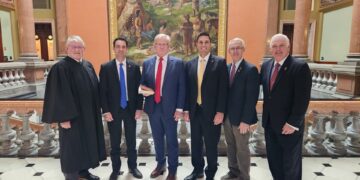By Hank Beckman -
I think I know what ails our national press corps. Many news outlets are in dire need of a Fair Witness.
Fair Witnesses were characters in Robert Heinlein’s science fiction classic, Stranger in a Strange Land.
Licensed, legally trained and required to have photographic memories, they were so dedicated to the concept of reporting only what they actually saw—with absolutely no conjecture on their part—that when one Fair Witness was asked what color a particular building was, she replied, “It’s white on this side.”
And if she went on the other side to report that it also was white, she wouldn’t assume it would stay white when she left because someone might have painted it in the meantime. This particular Fair Witness wouldn’t even assume the sun had come up on a cloudy morning, because someone might have put artificial light behind the clouds.
Granted, even those advocating the tightest rules for sourcing would find this standard a little extreme; the strictest professors in journalism school would likely balk at requiring proof that the sun had come up.
But recent history suggests that a serious commitment to healthy skepticism is sorely lacking, with the Jussie Smollett being only the most recent example.
Oh, it’s possible that a pair of MAGA hat—wearing Trump supporters assaulted the Empire actor on one of the coldest nights of the year in a thoroughly liberal Chicago neighborhood, poured bleach on him and tied a noose around his neck, all while he courageously fought back while conducting a phone conversation and holding on to his Subway sandwich.
But wouldn’t the first reaction of an honest journalist be a healthy skepticism? To their credit, some Chicago journalists quickly tweeted hints that they smelled a rat, but our national press corps found it entirely believable.
One news anchor after another reported the incident not as an accusation, not bothering to use the word “alleged,” but as a fact, with absolute certainty that the attack occurred.
“This is America, 2019,” CNN’s Brooke Baldwin solemnly declared.
Before that we saw the Covington Catholic kids become the focus of one of the Left’s patented two-minute hates.
On the basis of a short video, news anchors denounced the kids as arrogant representatives of all that’s wrong with the country, not only for their unforgivable whiteness and maleness, but for having the audacity to actually wear MAGA hats, thereby proving the toxic atmosphere created by our 45th president.
They appeared to have surrounded a Native America “elder,” acting out—smirking even—in a manner apparently exclusive to white males, if both liberal and conservative commentators were to be believed.
Only later, when a longer version of the video was released, was it revealed that the Native American—falsely described as a Vietnam Nam veteran—was the actual aggressor in the incident, walking right up to the kid and banging a drum and waving a wand in his face.
Our betters have yet to instruct us on proper etiquette for dealing with a total stranger banging a drum in your face while a group of African American racists nearby heap scorn on you for merely being white. A smirk seems like the least harmful reaction, but maybe someone has other ideas.
Then there was the matter of BuzzFeed reporting that President Trump instructed his lawyer to lie to the Congress about a property deal involving the Russians. The president was apparently in big trouble.
That is, he was in trouble, “if true,” as some networks and newspapers reported. That’s the phrase used by NBC, the Washington Post and USA Today.
Greg Sargent’s piece in the Washington Post was essentially fact-free, relying completely on Buzzfeed as evidence, invoking the “if true” scenario no less than three times, speculating the rest of the article.
But isn’t one of the first principles of journalism to find out if something is true before you print or broadcast it as fact? And when did another publication become a primary source for an article on a legal matter concerning the President of the United States?
CNN, in particular, seems particularly partial to reporting on the president with unnamed sources that sound suspiciously like voices inside reporters’ heads.
In June 2017 the network disputed Trump’s claim that then FBI Director James Comey told him he was not under investigation; Comey later confirmed Trump was telling the truth.
CNN also reported that Donald Trump, Jr. was privy to Hillary’s hacked emails from WikiLeaks on Sept. 4, of 2016, when it was actually Sept. 14, the day after the emails were released to the public; with the implication that Trump, Jr. was somehow in cahoots with WikiLeaks, the date was the whole story.
A month later, CNN reported that White House Communications Director Anthony Scaramucci was under investigation for meeting with Russian officials. Not true and another dud.
ABC’s Brian Ross apparently heard his own voices when, in December 2017, he reported that candidate Trump had instructed his future National Security Advisor to contact Russian officials, a possible violation of the Logan Act.
But it was actually president-elect Trump, doing something not at all out the ordinary. Ross’s exploding cigar got him suspended and he later left the network.
No one expects the press to be perfect, and it would be a little unreasonable to require verification that the sun came up on a cloudy day.
But maybe creeping a little closer to Fair Witness standards would allow national media to go back to just slanting the news left, instead of telling outright lies.







